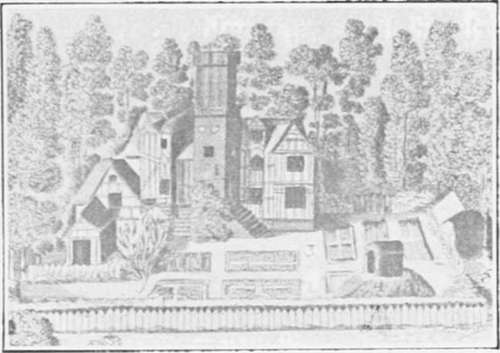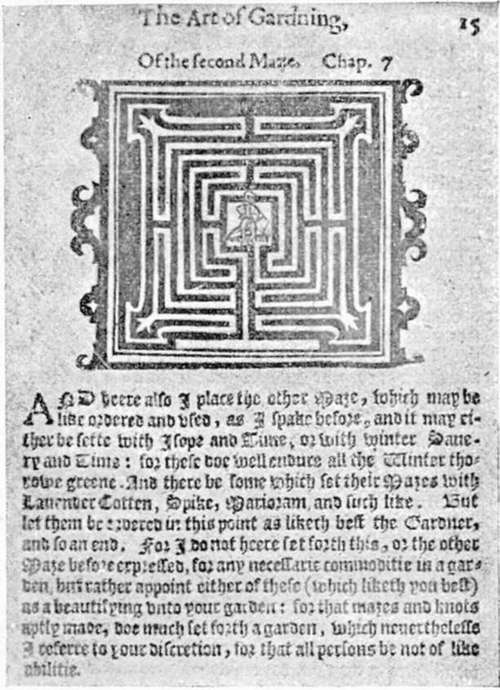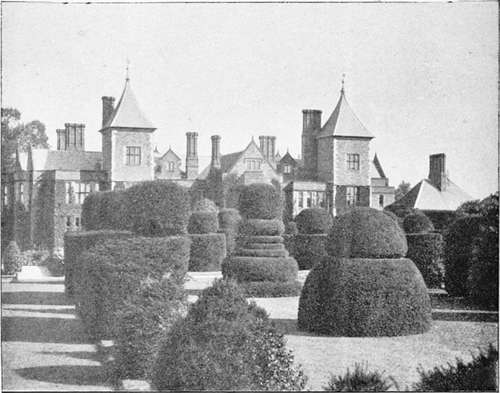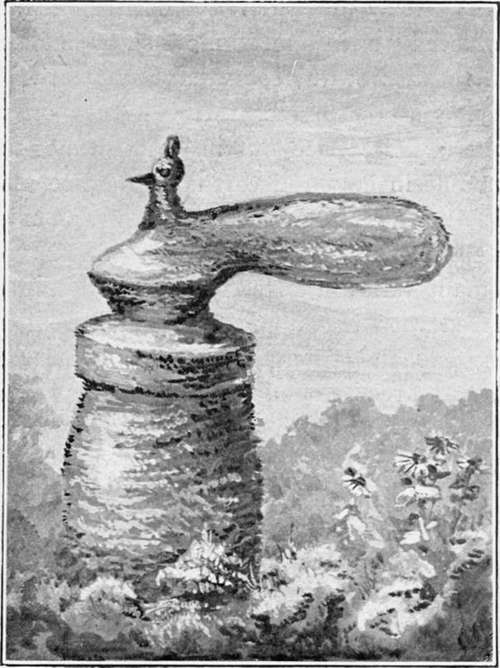Elizabethan Flower Garden. Part 4
Description
This section is from the book "A History Of Gardening In England", by Alicia Amherst. Also available from Amazon: A History Of Gardening In England.
Elizabethan Flower Garden. Part 4
The mount was not always a circular lump standing out in the garden; it appears that it was still sometimes banked up against the outside wall. Bacon describes this kind also : " At the end of both the side grounds," he writes, " I would have a mount of some pretty height, leaving the wall of the enclosure breast-high, to look abroad into the fields." The erections placed on the top of mounts did not do away with the use of other arbours in less exposed places in the garden. Some " arbour o'ergrown with woodbines,"* or "pleached bower where honeysuckles ripen'd by the sun, forbid the sun to enter," † were sure to be found in a secluded spot. " You may," writes Thomas Hill,‡ "make the herbes either straight or runing up, or else vaulted or close over the head, like to the vine herbers now adaies made. And if they be made with juniper-wood, you neede to repaire nothing thereof for ten years after; but if they be made with willow poles, then must you new repaire them euery 3 yeare after. And he which will set Roses to run about his herber, or beds round about his, must set them in Februarie. . . . And in the like manner you may doe, if you will sowe that sweet tree or flower named Jacemine, Rosemary, or the Pomegranate seedes, unless you had rather decke your herbers comelier with vines." We learn some of the other plants used for arbours from Parkinson. " The Jacimine, white and yellow, the double Honeysocke, the Ladies' Bower, both white and red and purple, single and double, are the fittest of outlandish plants to set by arbours and banquetting-houses that are open both before and above, to help to cover them, and to give both sight, smell, and delight." The " Ladies' Bower" is Clematis vitalba, or " traveller's joy," and some five foreign species of Clematis.§ Kidney beans were also employed. They " do easily and soone spring up, and growe into a very great length : being sowen neere vnto long poles fastened hard by them or hard by arbors and banquetting places." *
* Boscobel, or the History of His Sacred Majesties most miraculous Preser-vation after the Battle of Worcester, 3 Sept., 1651. By Thomas Blount, 1660;. reprint, 1822. The illustration on page 117 is from this work.

BOSCOBEL IN l660.
* Fletcher, Faithful Shepherdess.
† Much Ado About Nothing, act iii. scene I.
‡ Art of Gardening.
§ Paradisus, page 392.
Parkinson describes a curious arbour made in a lime tree. That tree, he says, "is planted to make goodly arbors, and summer banqueting-houses, either below upon the ground, the boughs serving very handsomely to plash round about it, or up higher for a second above it, and a third also." He goes on to explain the "goodliest spectacle that ever" his eyes beheld, was at Cobham, in Kent, where an arbour was made in this way, boards to tread on were laid on the first series of boughs 8 feet from the ground, the stem again kept bare of branches another 8 or 9 feet, and a second lot of branches plashed to form the roof of the middle, and the floor of yet a third arbour, and stairs arranged to mount up to it: the arbour, he says, would hold "half a hundred men at the least." † The following lines in Spenser's Faerie Qneene perhaps convey to us a more vivid impression of an Elizabethan arbour than the tumble-down, or overgrown, remains of one, in the corner of some, perchance, neglected garden, could possibly do :—
" And over him Art. striving to compare.
With Nature, did an arbour green dispread,
Fram'd of wanton ivy, flow'ring fair.
Through which the fragrant eglantine did spread.
His prickling arms, entrail'd with roses red.
Which dainty odours round about them threw:
And all within with flow'rs was garnished,
That, when mild Zcphyrus amongst them blew, Did breathe out bounteous smells and painted colour shew".
—Book II., Cantos V. 29.
The maze was another feature which now became prominent in many gardens. "There be some that set their mazes with Lavender, cotton spike, majoram and such like,‡ or Isope and Time, or quickset, privet, plashed fruit trees." Lawson gives directions for making mazes, and says, " When they are well formed of a man's height, your friend may perhaps wander in gathering berries till he cannot recover himself without your help." Thomas Hill gives two designs for mazes, though he says they are not " for any necessary commodotie in a garden, but rather" . . . "that who so listeth having such room in their garden may place the one of them . . in that void place . . . that may best be spared for the only purpose to sport in them at times." Many people, on the mention of the word maze, will at once think of the well-known example at Hampton Court, which affords so much amusement to thousands of Londoners, and holiday-makers; but that was not laid out rill a very much later date, probably in the year 1700.
* Gerard's Herbal, page 1141.
† Paradisus, page 610. ‡ Thomas Hill.

Maze.
Trees cut in fantastical shapes were frequently to be found between the hedges, dotted about and arranged so as to form vistas and walks. Bacon advises in "ordering of the ground within the great hedge " . . . . that " it be not too busy or full of work," or, as we should saw not too elaborate, and he adds, " I, for my part, do not like images cut out in juniper or other garden stuff—they be for children. Little low hedges round like welts, with some pretty pyramids, I like well, and in some places, fair columns".
The idea that cut trees were generally yews is very prevalent, and the remains of topiary work in old gardens still in existence confirm this impression. All the cut trees in the garden at Heslington, near York, are yews. This garden was laid out soon after the house was built, about 1560. The quaintly-rounded hedge at Rockingham, and the hedges and trees at Erbistock, are two examples of the cut yews of this date. But in the books of the period, other shrubs are spoken of more favourably than yews. It seems, therefore, that it is only because the yew is a slow grower, a sturdy tree, and an evergreen, that more yews than other shrubs have survived. Parkinson says of the "use of the yew," "It is found planted both in the corners of orchards and against the windows of houses, to be both a shadow and an ornament, it being always green." But of the privet he writes, " Because the use of this plant is so much, and so frequent throughout all this land, although for no other purpose but to make hedges or arbours in gardens, etc., whereunto it is so apt, that no other can be like unto it, to be cut, lead, and drawn into what forme one will, either of beasts, birds, or men armed or otherwise : I could not forget it, although it . . . . be an hedge bush." "Your Gardiner," writes Lawson in 1618, "can frame your lesser wood to the shape of men armed in the field, ready to give battell: or swift-running Grey Hounds to chase the Deere, or hunt the Hare. This kind of hunting shall not waste your corne, nor much your coyne." Rosemary also was " sette by women for their pleasure, to grow in sundry proportions, as in the fashion of a cart, a peacock, or such by things as they fancy." *

Heslington.

Examile of topiary work in cottage garden, haddon.
Continue to:
